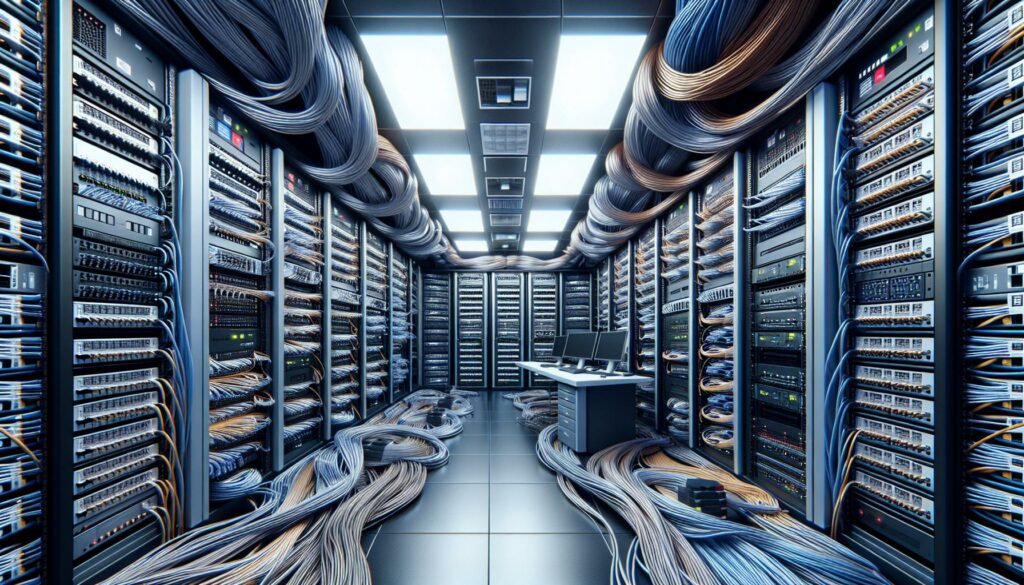
”
I’ve worked with telecommunications infrastructure for over a decade, and I can tell you that backbone cabling is the unsung hero of any building’s network system. It’s the critical pathway that connects telecommunications rooms, equipment rooms, and entrance facilities, ensuring seamless communication throughout an entire building or campus.
Think of backbone cabling as your building’s digital nervous system. Just as your nerves transmit signals throughout your body, backbone cables carry vital data, voice, and video signals between different areas of your facility. I’ve seen firsthand how proper backbone cabling design can make or break a network’s performance and reliability.
Key Takeaways
- Backbone cabling serves as the primary network connection between entrance facilities, equipment rooms, and telecommunications rooms, acting as a building’s digital nervous system
- Two main types of backbone cables exist: copper (supporting up to 40 Gbps) and fiber optic (supporting up to 400 Gbps), each with specific distance limitations and use cases
- Essential facility rooms include Telecommunications Rooms (TRs), Equipment Rooms (ERs), and Entrance Facilities (EFs), each serving distinct functions in the infrastructure
- Proper installation must follow TIA/EIA-568 standards and consider factors like bandwidth requirements, environmental conditions, and future scalability
- Regular maintenance and testing are crucial for optimal performance, including OTDR testing, cable certification, and environmental monitoring
The Cable That Connects The Telecommunications Rooms, Equipment Rooms, and Entrance Facilities.
Backbone cable connects telecommunications spaces through dedicated infrastructure pathways, serving as the primary network connection between entrance facilities, equipment rooms, and telecommunications rooms. My extensive experience shows that backbone cabling consists of fiber optic cables or high-capacity copper cables designed for high-speed data transmission.
The physical components of backbone cabling include:
- Main distribution frames for centralized network management
- Intermediate distribution frames for connecting different building levels
- Terminal blocks for secure cable terminations
- Cable management systems for organized routing
- Patch panels for flexible connectivity options
Here’s a breakdown of backbone cable types and their typical uses:
| Cable Type | Maximum Distance | Data Speed | Common Applications |
|---|---|---|---|
| Single-mode Fiber | 40km | 100 Gbps | Campus networks |
| Multimode Fiber | 550m | 40 Gbps | Building backbones |
| Cat 6A Copper | 100m | 10 Gbps | Floor distributions |
| Cat 7 Copper | 100m | 40 Gbps | Data centers |
Key features of backbone cabling include:
- Vertical connections between multiple floors in buildings
- Horizontal pathways across single-floor distributions
- Underground conduits for campus-wide connectivity
- Redundant paths for network reliability
- Fire-rated cable installations for safety compliance
- Star topology for centralized management
- Ring topology for redundant paths
- Tree topology for hierarchical networks
- Mesh topology for maximum reliability
- Hybrid topology for specialized requirements
Types of Backbone Cabling Systems
Backbone cabling systems consist of two primary cable types that connect telecommunications spaces. Each type offers distinct advantages for specific applications based on distance requirements, bandwidth needs, and environmental factors.
Copper Backbone Cables
Copper backbone cables transmit data through metallic conductors with varying specifications:
- Category 6A cables support 10 Gbps speeds up to 100 meters
- Category 7 cables deliver 40 Gbps speeds up to 50 meters
- Category 8 cables achieve 40 Gbps speeds up to 30 meters
- Shielded twisted pair (STP) cables protect against electromagnetic interference
- Multi-pair copper cables accommodate voice services with 25-100 pairs
| Cable Type | Max Speed | Max Distance | Best Use Case |
|---|---|---|---|
| Cat 6A | 10 Gbps | 100m | Floor distributions |
| Cat 7 | 40 Gbps | 50m | Data centers |
| Cat 8 | 40 Gbps | 30m | Server connections |
- Single-mode fiber spans up to 40 kilometers without signal regeneration
- Multimode fiber supports distances up to 550 meters
- OM4 multimode fiber delivers 100 Gbps over 150 meters
- OS2 single-mode fiber achieves 400 Gbps over 10 kilometers
- Armored fiber cables provide extra protection in harsh environments
| Fiber Type | Max Speed | Max Distance | Best Use Case |
|---|---|---|---|
| OM4 MM | 100 Gbps | 150m | Building backbones |
| OS2 SM | 400 Gbps | 10km | Campus networks |
| OM5 MM | 100 Gbps | 400m | Data centers |
Key Components and Layout
A structured backbone cabling system integrates three essential facility rooms connected through dedicated pathways. Each room serves specific functions in the telecommunications infrastructure while maintaining strict standards for equipment placement, accessibility, security.
Telecommunications Rooms
Telecommunications rooms (TRs) function as distribution points for horizontal cabling to work areas on each floor. These rooms house:
- Cross-connect hardware with patch panels for voice, data, video services
- Network switches with connections to backbone cables
- Cable management systems for organized routing paths
- Grounding busbars for electrical protection
- Environmental controls maintaining 64-80°F (18-27°C)
Equipment Rooms
Equipment rooms (ERs) serve as central connection points for building-wide network systems. Key components include:
- Core network switches supporting multiple TRs
- Server racks with dedicated power circuits
- Main cross-connect frames for backbone terminations
- UPS systems providing backup power
- Cable entrance protectors for external connections
- HVAC systems maintaining optimal operating temperatures
- Service provider termination equipment
- Primary protectors for copper cables
- Fiber optic splice enclosures
- Grounding systems for lightning protection
- Access control systems restricting entry
- Conduit pathways for external cable routing
| Room Type | Minimum Size | Temperature Range | Power Requirements |
|---|---|---|---|
| TR | 10′ x 8′ | 64-80°F | 20A dedicated circuit |
| ER | 15′ x 20′ | 64-75°F | 100A service |
| EF | 8′ x 10′ | 64-80°F | 50A dedicated circuit |
Installation Best Practices and Standards
Proper installation of backbone cabling requires adherence to TIA/EIA-568 standards ensuring optimal network performance. These standards establish specific guidelines for cable selection, installation methods, and distance requirements.
Cable Selection Guidelines
The selection of backbone cables depends on three critical factors:
- Bandwidth requirements determine the cable category (Cat 6A: 10Gbps, Cat 7: 40Gbps, Cat 8: 40Gbps)
- Environmental conditions dictate shielding needs (plenum-rated cables for air handling spaces)
- Future scalability influences the choice between copper or fiber optic cables
- Installation environment affects cable jacket types (riser-rated for vertical runs, waterproof for underground)
| Cable Type | Maximum Bandwidth | Best Use Case |
|---|---|---|
| Cat 6A | 10 Gbps | Short-distance backbone |
| Cat 7 | 40 Gbps | Data center connections |
| OM4 Fiber | 100 Gbps | Building backbone |
| OS2 Fiber | 400 Gbps | Campus backbone |
- Copper backbone cables:
- Cat 6A: 100 meters maximum length
- Cat 7: 100 meters at full bandwidth
- Cat 8: 30 meters for 40Gbps
- Fiber optic backbone cables:
- OM3 multimode: 300 meters at 10Gbps
- OM4 multimode: 550 meters at 10Gbps
- OS2 single-mode: 10 kilometers at 10Gbps
| Cable Type | Maximum Distance | Speed at Max Distance |
|---|---|---|
| Cat 6A | 100m | 10 Gbps |
| OM4 Fiber | 550m | 10 Gbps |
| OS2 Fiber | 10km | 10 Gbps |
Performance and Testing Considerations
Backbone cable performance relies on regular testing and monitoring to maintain optimal network functionality. These assessments ensure system reliability and help identify potential issues before they impact network operations.
Bandwidth Requirements
Backbone cabling bandwidth requirements vary based on specific network demands and applications:
| Network Type | Minimum Bandwidth | Recommended Cable Type |
|---|---|---|
| Enterprise LAN | 10 Gbps | OM4 Multimode Fiber |
| Data Center | 40/100 Gbps | Single-mode Fiber |
| Campus Network | 1-10 Gbps | Category 6A/7 Copper |
Key testing parameters include:
- Measuring throughput capacity using BERT (Bit Error Rate Testing)
- Validating maximum data transfer rates under peak loads
- Monitoring latency levels across backbone segments
- Assessing Quality of Service (QoS) metrics for different traffic types
- Regular Testing Procedures:
- Optical Time Domain Reflectometer (OTDR) testing for fiber segments
- Cable certification testing at installation
- Quarterly performance baseline measurements
- Monthly connector inspection and cleaning
- Critical Measurements:
- Insertion loss values for each cable segment
- Return loss measurements at connection points
- Cross-talk levels between adjacent cables
- Propagation delay across backbone runs
- Environmental Controls:
- Temperature monitoring in cable pathways
- Humidity level maintenance between 20-80%
- EMI/RFI shielding verification
- Physical strain relief inspection
- Documentation Requirements:
- Test results archive maintenance
- Cable performance trending analysis
- Signal degradation documentation
- Maintenance schedule tracking
Maintenance and Troubleshooting
Regular maintenance protocols enhance backbone cable performance through systematic inspection schedules:
- Check cable pathways monthly for physical damage
- Test fiber connections quarterly using OTDR measurements
- Monitor copper connections bi-annually with cable certification tools
- Document signal quality metrics weekly through network analytics
- Inspect cable management systems monthly for proper organization
Common backbone cabling issues require specific diagnostic approaches:
- Signal Loss
- Measure optical power levels
- Test for cable breaks or bends
- Verify connector cleanliness
- Check splice point integrity
- EMI Interference
- Scan for nearby power sources
- Test cable shielding effectiveness
- Measure ground connections
- Monitor error rates
- Network Latency
- Run end-to-end throughput tests
- Check bandwidth utilization
- Verify switch configurations
- Monitor packet loss rates
Essential testing equipment includes:
| Equipment Type | Function | Testing Frequency |
|---|---|---|
| OTDR | Measures fiber length/breaks | Quarterly |
| Power Meter | Tests signal strength | Monthly |
| Cable Analyzer | Verifies copper performance | Bi-annually |
| Network Tester | Checks connectivity | Weekly |
| TDR | Locates cable faults | As needed |
Preventive maintenance steps focus on these key areas:
- Clean fiber connectors with approved solutions bi-monthly
- Label all cables with updated identification tags
- Maintain proper bend radius in cable management systems
- Keep accurate documentation of maintenance activities
- Monitor environmental conditions in equipment rooms
| Parameter | Acceptable Range | Monitoring Frequency |
|---|---|---|
| Temperature | 64-80°F | Daily |
| Humidity | 30-55% | Daily |
| Airflow | 100 CFM min | Weekly |
| Dust Levels | <0.5mg/m³ | Monthly |
| Static Charge | <2kV | Weekly |
Cabling Role in Modern Telecommunication
I’ve explored the essential role backbone cabling plays in modern telecommunications infrastructure. It’s clear that selecting the right cable type and maintaining proper installation standards are crucial for optimal network performance.
Whether using fiber optic or copper cables the backbone serves as the lifeline of any telecommunications system. From Equipment Rooms to Entrance Facilities these critical connections demand careful planning regular testing and proactive maintenance.
A well-designed backbone cabling system ensures reliable high-speed connectivity while providing the scalability needed for future network expansions. By following industry standards and best practices organizations can build robust telecommunications infrastructures that meet both current and future demands.
“








